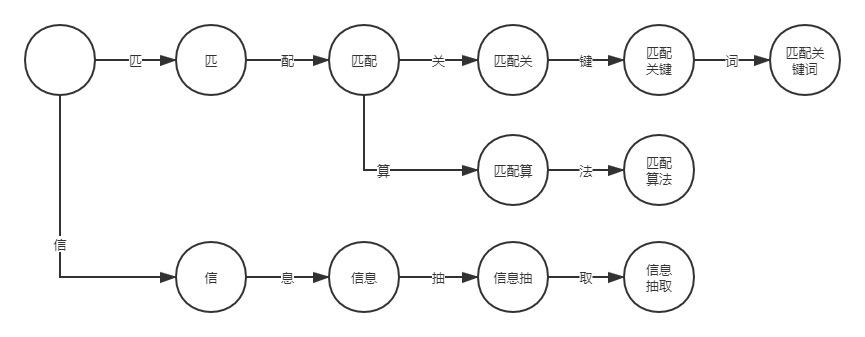淺析Python實現(xiàn)DFA算法
計算機(jī)操作系統(tǒng)中的進(jìn)程狀態(tài)與切換可以作為 DFA 算法的一種近似理解。如下圖所示,其中橢圓表示狀態(tài),狀態(tài)之間的連線表示事件,進(jìn)程的狀態(tài)以及事件都是可確定的,且都可以窮舉。

DFA 算法具有多種應(yīng)用,在此先介紹在匹配關(guān)鍵詞領(lǐng)域的應(yīng)用。
二、匹配關(guān)鍵詞我們可以將每個文本片段作為狀態(tài),例如“匹配關(guān)鍵詞”可拆分為“匹”、“匹配”、“匹配關(guān)”、“匹配關(guān)鍵”和“匹配關(guān)鍵詞”五個文本片段。

【過程】:
初始狀態(tài)為空,當(dāng)觸發(fā)事件“匹”時轉(zhuǎn)換到狀態(tài)“匹”; 觸發(fā)事件“配”,轉(zhuǎn)換到狀態(tài)“匹配”; 依次類推,直到轉(zhuǎn)換為最后一個狀態(tài)“匹配關(guān)鍵詞”。再讓我們考慮多個關(guān)鍵詞的情況,例如“匹配算法”、“匹配關(guān)鍵詞”以及“信息抽取”。

可以看到上圖的狀態(tài)圖類似樹形結(jié)構(gòu),也正是因為這個結(jié)構(gòu),使得 DFA 算法在關(guān)鍵詞匹配方面要快于關(guān)鍵詞迭代方法(for 循環(huán))。經(jīng)常刷 LeetCode 的讀者應(yīng)該清楚樹形結(jié)構(gòu)的時間復(fù)雜度要小于 for 循環(huán)的時間復(fù)雜度。
for 循環(huán):
keyword_list = []for keyword in ['匹配算法', '匹配關(guān)鍵詞', '信息抽取']: if keyword in 'DFA 算法匹配關(guān)鍵詞':keyword_list.append(keyword)
for 循環(huán)需要遍歷一遍關(guān)鍵詞表,隨著關(guān)鍵詞表的擴(kuò)充,所需的時間也會越來越長。
DFA 算法:找到“匹”時,只會按照事件走向特定的序列,例如“匹配關(guān)鍵詞”,而不會走向“匹配算法”,因此遍歷的次數(shù)要小于 for 循環(huán)。具體的實現(xiàn)放在下文中。
【問】:那么如何構(gòu)建狀態(tài)圖所示的結(jié)構(gòu)呢?
【答】:在 Python 中我們可以使用 dict 數(shù)據(jù)結(jié)構(gòu)。
state_event_dict = { '匹': {'配': { '算': {'法': { 'is_end': True},'is_end': False }, '關(guān)': {'鍵': { '詞': {'is_end': True }, 'is_end': False},'is_end': False }, 'is_end': False},'is_end': False }, '信': {'息': { '抽': {'取': { 'is_end': True},'is_end': False }, 'is_end': False},'is_end': False }}
用嵌套字典來作為樹形結(jié)構(gòu),key 作為事件,通過 is_end 字段來判斷狀態(tài)是否為最后一個狀態(tài),如果是最后一個狀態(tài),則停止?fàn)顟B(tài)轉(zhuǎn)換,獲取匹配的關(guān)鍵詞。
【問】:如果關(guān)鍵詞存在包含關(guān)系,例如“匹配關(guān)鍵詞”和“匹配”,那么該如何處理呢?
【答】:我們?nèi)匀豢梢杂?is_end 字段來表示關(guān)鍵詞的結(jié)尾,同時添加一個新的字段,例如 is_continue 來表明仍可繼續(xù)進(jìn)行匹配。除此之外,也可以通過尋找除 is_end 字段外是否還有其他的字段來判斷是否繼續(xù)進(jìn)行匹配。例如下面代碼中的“配”,除了 is_end 字段外還有“關(guān)”,因此還需要繼續(xù)進(jìn)行匹配。
state_event_dict = { '匹': {'配': { '關(guān)': {'鍵': { '詞': {'is_end': True }, 'is_end': False},'is_end': False }, 'is_end': True},'is_end': False }}
接下來,我們來實現(xiàn)這個算法。
三、算法實現(xiàn)使用 Python 3.6 版本實現(xiàn),當(dāng)然 Python 3.X 都能運(yùn)行。
3.1、構(gòu)建存儲結(jié)構(gòu)def _generate_state_event_dict(keyword_list: list) -> dict: state_event_dict = {} # 遍歷每一個關(guān)鍵詞 for keyword in keyword_list:current_dict = state_event_dictlength = len(keyword)for index, char in enumerate(keyword): if char not in current_dict:next_dict = {'is_end': False}current_dict[char] = next_dictcurrent_dict = next_dict else:next_dict = current_dict[char]current_dict = next_dict if index == length - 1:current_dict['is_end'] = True return state_event_dict
關(guān)于上述代碼仍然有不少可迭代優(yōu)化的地方,例如先對關(guān)鍵詞列表按照字典序進(jìn)行排序,這樣可以讓具有相同前綴的關(guān)鍵詞集中在一塊,從而在構(gòu)建存儲結(jié)構(gòu)時能夠減少遍歷的次數(shù)。
3.2、匹配關(guān)鍵詞def match(state_event_dict: dict, content: str): match_list = [] state_list = [] temp_match_list = [] for char_pos, char in enumerate(content):# 首先找到匹配項的起點if char in state_event_dict: state_list.append(state_event_dict) temp_match_list.append({'start': char_pos,'match': '' })# 可能會同時滿足多個匹配項,因此遍歷這些匹配項for index, state in enumerate(state_list): if char in state:state_list[index] = state[char]temp_match_list[index]['match'] += char# 如果抵達(dá)匹配項的結(jié)尾,表明匹配關(guān)鍵詞完成if state[char]['is_end']: match_list.append(copy.deepcopy(temp_match_list[index])) # 如果還能繼續(xù),則繼續(xù)進(jìn)行匹配 if len(state[char].keys()) == 1:state_list.pop(index)temp_match_list.pop(index) # 如果不滿足匹配項的要求,則將其移除 else:state_list.pop(index)temp_match_list.pop(index) return match_list3.3、完整代碼
import reimport copyclass DFA: def __init__(self, keyword_list: list):self.state_event_dict = self._generate_state_event_dict(keyword_list) def match(self, content: str):match_list = []state_list = []temp_match_list = []for char_pos, char in enumerate(content): if char in self.state_event_dict:state_list.append(self.state_event_dict)temp_match_list.append({ 'start': char_pos, 'match': ''}) for index, state in enumerate(state_list):if char in state: state_list[index] = state[char] temp_match_list[index]['match'] += char if state[char]['is_end']:match_list.append(copy.deepcopy(temp_match_list[index]))if len(state[char].keys()) == 1: state_list.pop(index) temp_match_list.pop(index)else: state_list.pop(index) temp_match_list.pop(index)return match_list @staticmethod def _generate_state_event_dict(keyword_list: list) -> dict:state_event_dict = {}for keyword in keyword_list: current_dict = state_event_dict length = len(keyword) for index, char in enumerate(keyword):if char not in current_dict: next_dict = {'is_end': False} current_dict[char] = next_dict current_dict = next_dictelse: next_dict = current_dict[char] current_dict = next_dictif index == length - 1: current_dict['is_end'] = Truereturn state_event_dictif __name__ == '__main__': dfa = DFA(['匹配關(guān)鍵詞', '匹配算法', '信息抽取', '匹配']) print(dfa.match('信息抽取之 DFA 算法匹配關(guān)鍵詞,匹配算法'))
輸出:
[
{
’start’: 0,
’match’: ’信息抽取’
}, {
’start’: 12,
’match’: ’匹配’
}, {
’start’: 12,
’match’: ’匹配關(guān)鍵詞’
}, {
’start’: 18,
’match’: ’匹配’
}, {
’start’: 18,
’match’: ’匹配算法’
}
]
四、其他用法4.1、添加通配符在敏感詞識別時往往會遇到同一種類型的句式,例如“你這個傻X”,其中 X 可以有很多,難道我們需要一個個添加到關(guān)鍵詞表中嗎?最好能夠通過類似正則表達(dá)式的方法去進(jìn)行識別。一個簡單的做法就是“*”,匹配任何內(nèi)容。
添加通配符只需要對匹配關(guān)鍵詞過程進(jìn)行修改:
def match(self, content: str): match_list = [] state_list = [] temp_match_list = [] for char_pos, char in enumerate(content):if char in self.state_event_dict: state_list.append(self.state_event_dict) temp_match_list.append({'start': char_pos,'match': '' })for index, state in enumerate(state_list): is_find = False state_char = None # 如果是 * 則匹配所有內(nèi)容 if '*' in state:state_list[index] = state['*']state_char = state['*']is_find = True if char in state:state_list[index] = state[char]state_char = state[char]is_find = True if is_find:temp_match_list[index]['match'] += charif state_char['is_end']: match_list.append(copy.deepcopy(temp_match_list[index])) if len(state_char.keys()) == 1:state_list.pop(index)temp_match_list.pop(index) else:state_list.pop(index)temp_match_list.pop(index) return match_list
main() 函數(shù)。
if __name__ == '__main__': dfa = DFA(['匹配關(guān)鍵詞', '匹配算法', '信息*取', '匹配']) print(dfa.match('信息抽取之 DFA 算法匹配關(guān)鍵詞,匹配算法,信息抓取'))
輸出:
[
{
’start’: 0,
’match’: ’信息抽取’
}, {
’start’: 12,
’match’: ’匹配’
}, {
’start’: 12,
’match’: ’匹配關(guān)鍵詞’
}, {
’start’: 18,
’match’: ’匹配’
}, {
’start’: 18,
’match’: ’匹配算法’
}, {
’start’: 23,
’match’: ’信息抓取’
}
]
以上就是淺析Python實現(xiàn)DFA算法的詳細(xì)內(nèi)容,更多關(guān)于Python DFA算法的資料請關(guān)注好吧啦網(wǎng)其它相關(guān)文章!
相關(guān)文章:
1. ASP.NET MVC實現(xiàn)下拉框多選2. JSP中param動作的實例詳解3. Jsp servlet驗證碼工具類分享4. ASP.NET MVC實現(xiàn)本地化和全球化5. 解決request.getParameter取值后的if判斷為NULL的問題6. .NET Framework各版本(.NET2.0 3.0 3.5 4.0)區(qū)別7. .Net反向代理組件Yarp用法詳解8. ASP.NET MVC增加一條記錄同時添加N條集合屬性所對應(yīng)的個體9. 刪除docker里建立容器的操作方法10. .NET中的MassTransit分布式應(yīng)用框架詳解

 網(wǎng)公網(wǎng)安備
網(wǎng)公網(wǎng)安備